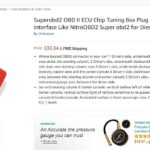Imagine diagnosing your car troubles using just your iPhone or iPad, without needing expensive, manufacturer-specific tools. With the right app and a simple device, you can understand why your check engine light is on, clear error codes, and monitor your vehicle’s health in real-time.
This is the power of OBD2 and EOBD, and with user-friendly applications, automotive diagnostics are now more accessible than ever. By connecting an ELM327 device to your car’s OBD2 port and running a compatible app, you gain the ability to perform car diagnostics, clear malfunction indicator lights, and access a wealth of vehicle data.
Decoding Your Car: OBD2 and EOBD Explained
OBD2 (On-Board Diagnostics II) and EOBD (European On-Board Diagnostics) are standardized systems that allow you to access your vehicle’s computer and retrieve valuable information about its operation and health. EOBD is essentially the European equivalent of OBD2, with similar functionalities and regulations. These systems were mandated to monitor emissions and ensure vehicles meet environmental standards, but they also provide a wealth of diagnostic data for mechanics and car owners alike.
At the heart of this system is the standardized OBD2 port, usually located within easy reach inside your car’s cabin. This port is the gateway to your car’s computer, allowing communication with diagnostic tools.
Connecting an ELM327 adapter to this port acts as a bridge, translating your car’s data into a format that your smartphone or computer can understand. This adapter, combined with the right software, turns your mobile device into a powerful diagnostic tool.
Key Diagnostic Functions at Your Fingertips
With an OBD2/EOBD compatible app and an ELM327 adapter, you can perform a range of diagnostic functions, giving you insights into your car’s condition:
-
Reading Diagnostic Trouble Codes (DTCs): The app can read engine and gearbox fault codes, also known as DTCs (Diagnostic Trouble Codes). These codes are essentially error messages from your car’s computer, indicating a problem in a specific system. The application provides clear explanations of these codes in English, drawing from a comprehensive database of over 11,000 definitions. This eliminates the guesswork and helps you pinpoint the source of the issue.
-
Clearing the Check Engine Light: Once you’ve addressed the issue causing the fault code, you can use the app to clear the malfunction indicator light, commonly known as the “check engine light.” This light illuminates on your dashboard when the car’s computer detects a problem. Clearing the code turns off the light, but it’s crucial to actually fix the underlying problem first, rather than just masking the symptom.
-
Manufacturer-Specific Error Codes: Beyond standard OBD2 codes, the application supports specific manufacturer error codes for a wide range of popular car brands, including Renault, Peugeot, Citroën, Opel, BMW, Ford, Audi, Volkswagen, Skoda, Fiat, and Alfa Romeo. This enhanced coverage provides more detailed diagnostics for these makes.
-
Real-time Sensor Data Monitoring: The app allows you to view real-time data from your vehicle’s sensors. Depending on your car’s specific configuration and sensors, you can monitor parameters such as car speed, engine speed (RPM), engine temperature, spark timing, intake air quantity, torque, and much more. This live data stream is invaluable for understanding how your car is performing under different conditions. You can even save this sensor data to a file for later analysis.
-
Journey Recording and Playback: The application offers the ability to record your journeys using your iPhone or iPad. These recordings can be reviewed later using companion PC/Mac software (“EOBD-Facile”), allowing you to analyze sensor data in relation to your driving routes and conditions.
-
GPS Data Integration: For more detailed journey analysis, you can create recordings that include GPS data in the .kml format. This allows you to overlay vehicle sensor data onto maps, providing a comprehensive view of your car’s performance in specific locations and driving scenarios.
Getting Started with OBD2 Diagnostics
To begin diagnosing your car with your iPhone/iPad, you will need two key components:
- A Compatible ELM327 WiFi Interface: This device plugs into your car’s OBD2 port and communicates wirelessly with your smartphone or tablet.
- An OBD2/EOBD Diagnostic Application: Software installed on your iPhone/iPad that interprets the data from the ELM327 interface and presents it in a user-friendly format. Applications like EOBD-Facile offer a comprehensive suite of diagnostic features.
It’s important to ensure that your vehicle is compatible with the EOBD/OBD2 standard. You can typically check compatibility information on the application’s website or consult resources like vehicle compatibility lists provided by OBD2 tool vendors.
By leveraging the power of OBD2 and EOBD diagnostics with your smartphone and an ELM327 adapter, you can gain valuable insights into your car’s health, troubleshoot issues effectively, and potentially save money on professional mechanic visits for routine diagnostics.
